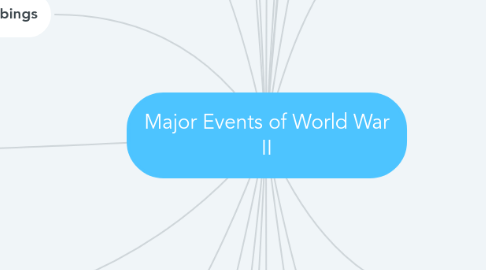
1. Battle of the Bulge
1.1. December 16, 1944 - January 1, 1945
1.2. Final German offensive in the west
1.2.1. Nazi attempt to re-conquer Belgium and spilt Allied forces
1.3. Caught the Allies completely off guard
1.3.1. American forces bore brunt of the attack
1.3.1.1. Largest and bloodiest battle fought by the US in WWII
1.4. Major causaltieis on both sides
1.5. Initial German sucess later led to Nazi defeat
1.5.1. (Did not achieve goals)
2. Germany Surrenders
2.1. To western Allies
2.1.1. May 7, 1945
2.2. To the Soviets
2.2.1. May 9, 1945
3. Atomic Bombings
3.1. The U.S., wanted to force Japanese surrender
3.1.1. President Truman orders the use of nuclear weapons
3.1.1.1. Aug. 6, 1945: The U.S. drops an atomic bomb on Hiroshima.
3.1.1.2. Aug. 9, 1945: The U.S. drops an atomic bomb on Nagasaki.
3.1.1.3. Together they kill at least 129, 000 people.
3.1.1.4. Remains only use of nuclear warfare to date
4. Japan Surrenders
4.1. Aug 14, 1945: Japan agrees to unconditional surrender
4.2. Sept. 2, 1945: Japan formally surrenders
4.3. This ends WWII.
5. Battle of Midway
5.1. June 4-7, 1942
5.2. Naval battle between U.S. and Japan in Pacific
5.3. Decisive Japanese defeat
5.3.1. Devasting for Japan
6. World Leaders of WWII
6.1. Allies
6.1.1. Britain
6.1.1.1. Neville Chamberlain
6.1.1.1.1. Prime Minister from 1937-1940
6.1.1.2. Winston Churchill
6.1.1.2.1. Prime Minister from 1940-1945
6.1.2. Soviet Union (USSR)
6.1.2.1. Joseph Stalin
6.1.2.1.1. Communist dictator from 1929=2953
6.1.3. United States
6.1.3.1. Franklin Delano Roosevelt (FDR)
6.1.3.1.1. President from 1933-1945
6.1.3.2. Harry Truman
6.1.3.2.1. President from 1945-1953
6.1.4. France
6.1.4.1. Charles de Gaulle
6.1.4.1.1. French general who later became president
6.2. Axis Powers
6.2.1. Germany
6.2.1.1. Adolf Hitler
6.2.1.1.1. Dictator from 1934-1945
6.2.2. Japan
6.2.2.1. Hideki Tojo
6.2.2.1.1. Prime minister from 1941-1944
6.2.3. Italy
6.2.3.1. Benito Mussolini
6.2.3.1.1. Prime minister from 1922-1943
7. D-Day
7.1. June 6, 1944
7.2. General Dwight Eisenhower led U.S. and Allied Troops
7.2.1. Invasion of Normandy, France
7.3. Opened "Second Front" against the Germans
7.3.1. Began liberation of northwestern Nazi-controlled territories
7.4. Extreme defeat for the Germans
7.4.1. Leads to eventual Nazi surrender
7.5. Largest seaborne invasion in history
8. Adolf Hitler commits suicide
8.1. April 30, 1945
9. Anti-Semitism and the Holocaust during the war
9.1. From 1933-1945
9.1.1. Jewish people in Germany and Germany-controlled lands suffer
9.1.1.1. Blamed as scape-goat for WWI
9.1.1.2. Limited and denied citizen ship by Nazi legislation
9.1.1.2.1. Ex: Forced to wear the Star of David
9.1.1.3. Sent to ghettos and later concentration camps
9.1.1.3.1. Killed by the millions
9.1.1.4. Nazi commit many other unspeakable horrors towards Jewish people
9.2. August 15, 1942
9.2.1. Gerhart Riegner informs US and Britain about mass murders
9.3. Jan 27, 1945
9.3.1. Soviet troops liberate Auschwitz (concentration camp)
9.3.1.1. Appox. 7, 000 prisoners left behind
9.4. November 20, 1945
9.4.1. International Military Tribunal of Nazi leaders begins
9.4.1.1. 18 convicted for unspeakable crimes
9.4.1.1.1. 11 sentenced to death
10. Fighting in Africa
10.1. May 12, 1943: Allied forces capture Italian forces in Tuinsia
10.2. Sept 3, 1943
10.2.1. Italy surrenders
11. Declaration of War
11.1. Sept. 1, 1939: Adolf Hitler (Germany) invades Poland
11.1.1. Sept. 3, 1939: Great Britain and France declare war on Germany
11.1.1.1. Because of Mutual Assistance treaty
11.2. Sept. 17, 1939: The Soviet Union invades Poland
11.3. June 10, 1949: Italy enters the war by invading southern France
11.4. December 8, 1941: U.S. declares war on Japan
11.4.1. In response to Pearl Harbor bombing
11.4.2. December 11-13, 1941: Axis Powers declare war on United States
12. Bombing of Pearl Harbor
12.1. December 7, 1941
12.2. Japan bombs Pearl Harbor
12.2.1. Pearl Harbor = important U.S. naval base in the Pacific
12.2.2. Unprovoked, suprise aerial assault
12.2.3. 400 soliders killed, 1,200 wounded
12.3. FDR
12.3.1. Day that would, "live in infamy"
12.3.2. December 8, 1941: U.S. declares war on Japan
13. Battle of Britain
13.1. July 10, 1940 - October 31, 1940
13.2. The Royal Air Force (RAF) defended the United Kingdom (UK) against the German Air Force (Luftwaffe).
13.3. First major campaign fought entirely by air forces
13.4. Ended in Nazi defeat
14. Tripartite (Berlin) Pact
14.1. Signed on Sept 26, 1940
14.2. By; Germany, Japan, and Italy
14.3. Defensive military alliance
14.3.1. Created the Axis Powers (officially)
14.4. Later joined by
14.4.1. Hungary
14.4.1.1. November 20, 1940
14.4.2. Romania
14.4.2.1. November 23, 1940
14.4.3. Slovakia
14.4.3.1. November 24, 1940
14.4.4. Bulgaria
14.4.4.1. March 1, 1941
14.4.5. Yugoslavia
14.4.5.1. March 25, 1941
15. Invasion of Soviet Union
15.1. July 22, 1941
15.2. Axis powers invade Soviet Union
15.2.1. Breaks Nonaggression Pact between Germany and the USSR
16. Poland Surrenders
16.1. Sept. 27, 1939: Warsaw (capital of Poland) surrenders
16.1.1. Polish leaders exiled to Romania
16.1.1.1. Germany and the USSR split Poland lands.
17. April 9, 1940: Germany invades Denmark and Norway
17.1. April 9, 1940: Denmark surrenders
17.2. June 9, 1940: Norway surrenders
18. Germany attacks western Europe
18.1. May 10, 1940: Luxembourg is occupied
18.2. May 14, 1940: The Netherlands surrenders
18.3. May 28, 1940: Belgium surrenders
18.4. June 22, 1940: France signs an armistice agreement with Germany
19. Bombing of Germany
19.1. May 30, 1942: The British bomb Köln
19.1.1. Brings war to Germany for first time
19.2. From 1942-1945
19.2.1. Allied bombing reduces urban Germany to rubble
20. Battle of Stalingrad
20.1. August 23, 1942 - February 2, 1943
20.2. Axis powers fought USSR for control of Stalingrad in southern Russia
20.3. Marked by close-quarters combat and air raids on civiliands
20.4. One of the single largest and bloodies battles of the war
20.4.1. Over 400, 000 casualties on both sides
20.5. Germans suffer severe Russian winter
20.6. Soviets trap German Sixth Army in the city
20.7. Survivors surrender
20.7.1. January 30, 1943
20.7.2. February 2, 1943
